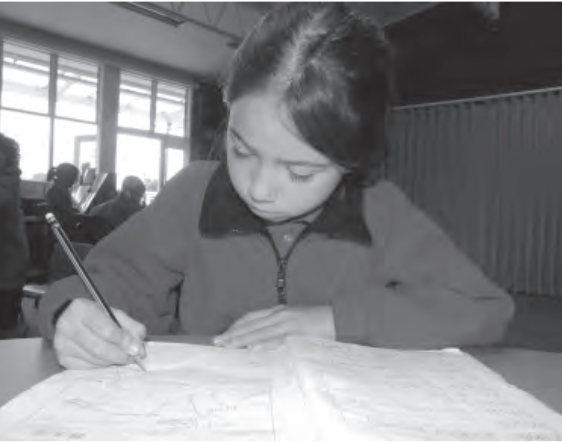I TE TAU TUATORU
TE ARA WHAKAAKO I TE TUHITUHI
Whārangi Ihirangi
Mātua ko te Kōtuitui
Kaiako should explicitly plan to integrate the language strands, whakarongo, kōrero, pānui, tuhituhi, mātakitaki and whakaatu.
Language competency is critical for ākonga to successfully access the curriculum and learning that is relevant to their world.
It is important to make connections across the curriculum between prior knowledge and new knowledge by providing a range of stimulating and engaging experiences.
I te tau tuatoru: Te Ara Whakaako i te Tuhituhi
Te whakamāramatanga me ngā āhuatanga
TUHITUHI NGĀTAHI | SHARED WRITING
Tuhituhi Ngātahi is a collaborative writing experience between a kaiako and a group of ākonga. The kaiako takes on the role of scribe, recording the ideas and contributions of the ākonga. This approach allows the kaiako to model being a writer.
Te whakamāramatanga me ngā āhuatanga
TUHITUHI MOTUHAKE | INDEPENDENT WRITING
Tuhituhi Motuhake refers to ākonga generating content on their own. The focus is on fostering a love of writing. The writer also has the opportunity to practice their knowledge, skills and strategies without direct support from the kaiako.
Te whakamāramatanga me ngā āhuatanga
TUHITUHI ARAHANGA | GUIDED WRITING
Tuhituhi Arahanga is an instructional approach where a kaiako works with a small group of ākonga who are at a similar writing level or have similar instructional needs. The focus is on the kaiako providing support and guidance in aspects of the writing process such as planning and rehearsing what they intend to write, drafting, revising, editing and publishing as appropriate.
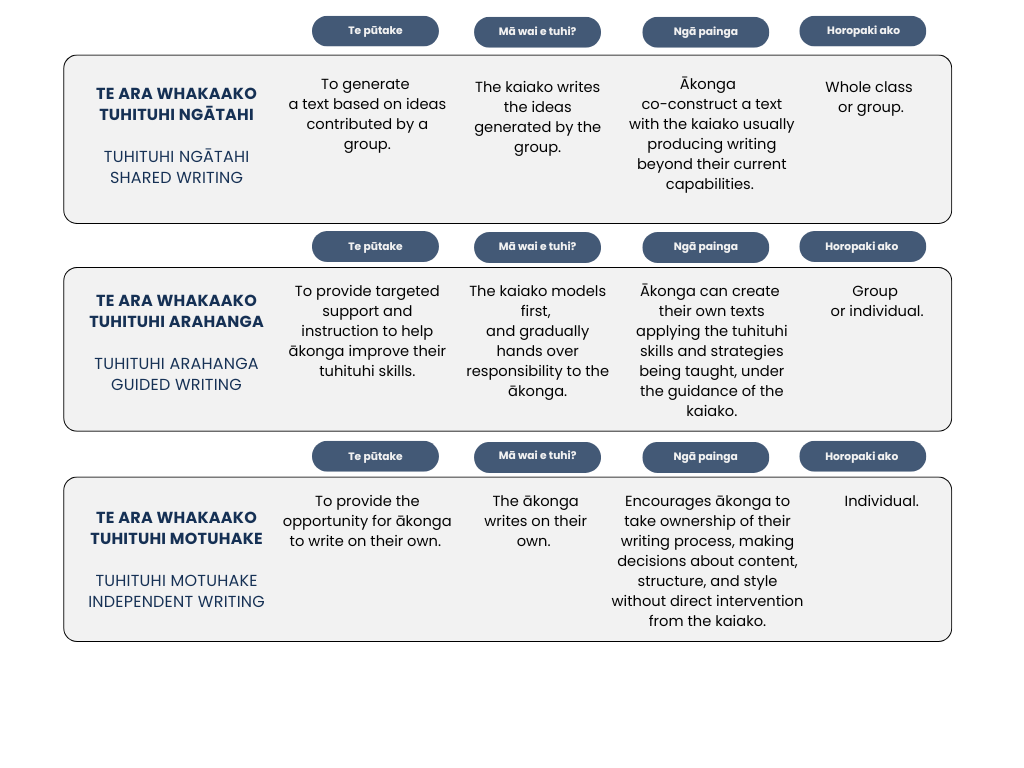
I te tau tuatoru: Te Whakahaere i te Tuhituhi Ngātahi
This lesson sequence outlines the steps that the kaiako and ākonga go through during a shared writing session, such as when teaching writing for a specific purpose. Depending on the lesson’s purpose and the individual needs of the ākonga, the kaiako may work with the whole class or with a small group.
In the first three years of kura, ākonga should be exposed to and engaged in shared writing for the following writing purposes:
Writing about personal experiences, thoughts, and feelings.
Creating stories, narratives, and imaginative texts.
Providing information or facts about topics of interest or learning.
Writing to explain or instruct, such as giving directions or procedures.
Writing that reflects on experiences, learning, or personal growth.
Using language to describe people, places, objects, or events vividly.
Writing to explain a natural or man-made phenomenon by answering a research question.
Through these purposes, shared writing helps ākonga develop foundational writing skills, confidence in their abilities, and an understanding of how written language communicates meaning effectively.
Te tukanga tuhituhi ngātahi
Whakarite
Introduce the writing task, lesson focus and the writing's purpose and audience.
Brainstorm ideas and organise them into a clear plan.
Whakatakoto
Demonstrate and model writing strategies, thinking aloud to show how to sound out new and unfamiliar words and how sentences are constructed.
Use a modeling book.
Whakamārama
Ākonga share ideas and suggestions for the writing.
Kaiako writes the text in front of the class, showing how their ideas are transformed into written words.
Whakatika
The class or group reviews the draft together, discussing ways to make the writing clearer and more effective.
Rephrase sentences, add details, and correct spelling and grammar mistakes where needed.
Whakaputa
The final version of the text is prepared for sharing with a wider audience.
Kaiako helps ākonga understand the importance of creating polished, well-presented work for the reading audience.
I te tau tuatoru: Te Whakahaere i te Tuhituhi Arahanga
Introduction and Purpose Setting:
Kaiako introduces specific writing tasks or skills that will be focussed on. E.g. consolidation and integration of skills taught.
Ākonga will learn and understand the importance of learning specific writing tasks and skills and what they will gain from practising and using them in their writing.
Modelling and Demonstration:
Kaiako demonstrates focus writing skills or techniques.
Ākonga will listen and watch the kaiako explain their thought process while writing, and use this to help with their own writing.
Guided Practice:
Ākonga practices the new skill with kaiako guidance.
Kaiako provides immediate feedback, offering tips, advice and assistance as needed.
Independent Practice:
Ākonga then apply the skill independently in their own writing.
Ākonga will provide help and encouragement as needed.
Sharing and Reflecting:
Ākonga share their writing with peers or the class.
Kaiako and peers will give constructive feedback to the writer, focussing on strengths and areas of improvement.
Ākonga will reflect on what they have learned and how they can utilise these skills it in future writing.
I te tau tuatoru: Tuhinga Māhorahora
Write everyday about topics of their choosing.
Write about their own experiences and things they might imagine.
Begin to notice, wonder, ask questions and explore new ideas through writing.
Take a chosen piece of tuhinga māhorahora and work on it through the writing process to prepare it for publishing.
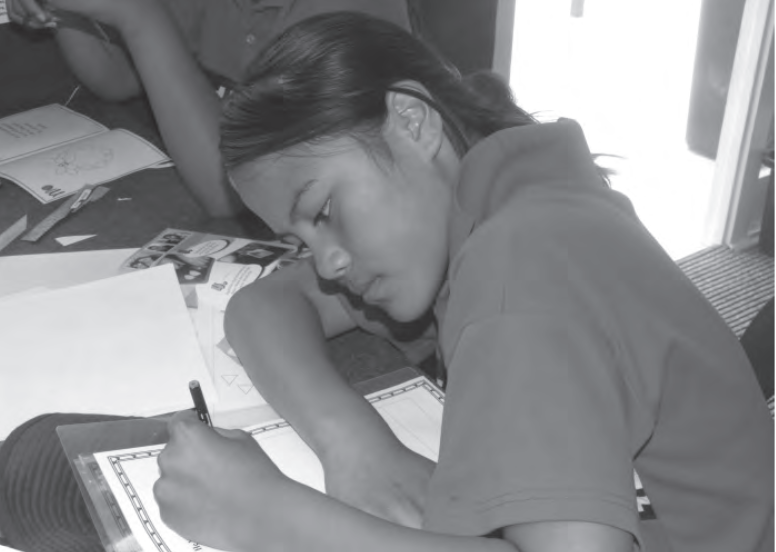
I te tau tuatoru: Ngā Toi Mokopuna - Tuhituhi
This section outlines the skills, strategies and knowledge required in tuhituhi in the first three years.
I ngā marama e ono
I te tau tuatahi
I ngā marama tekau ma waru ki te tau tuatoru
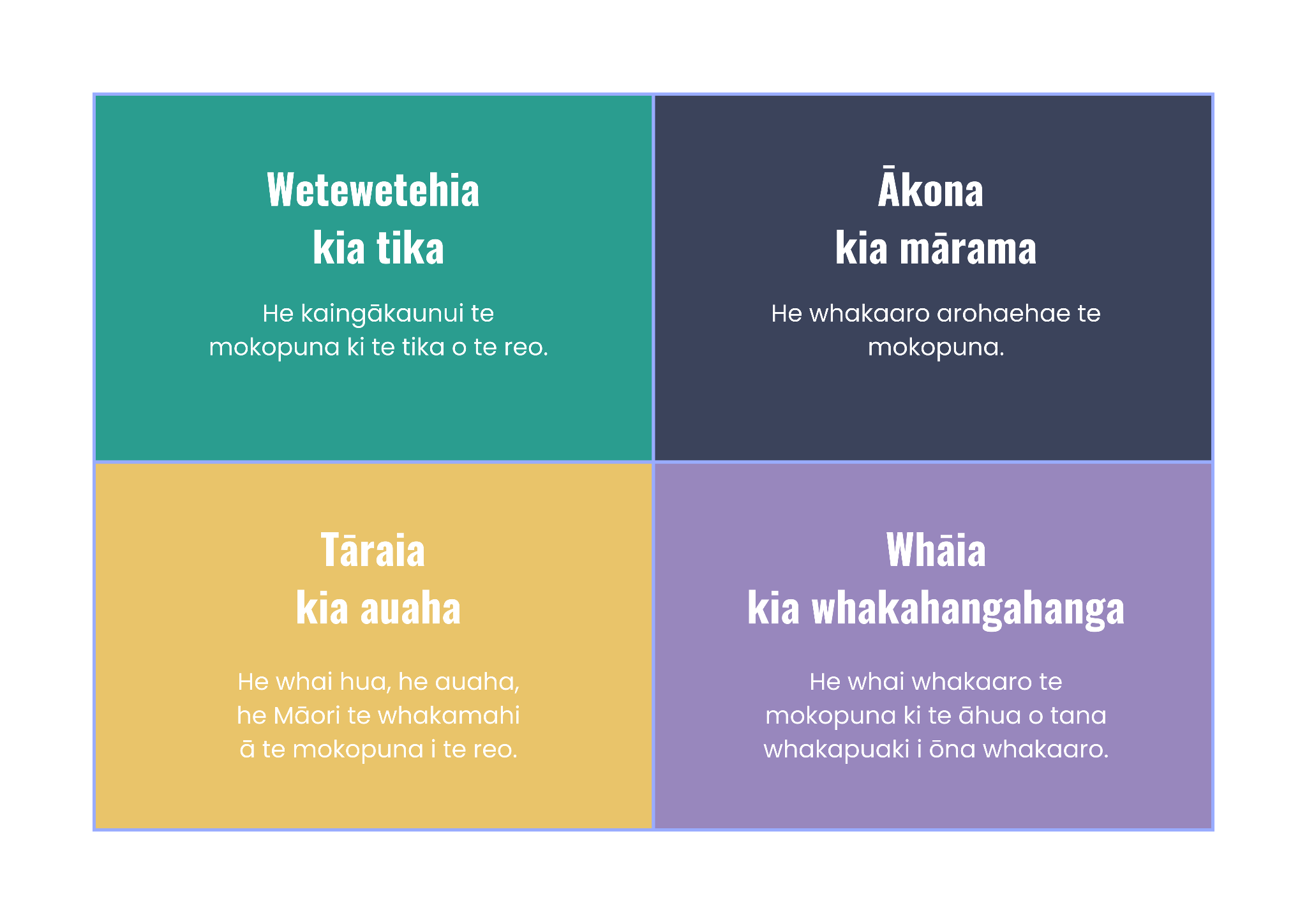
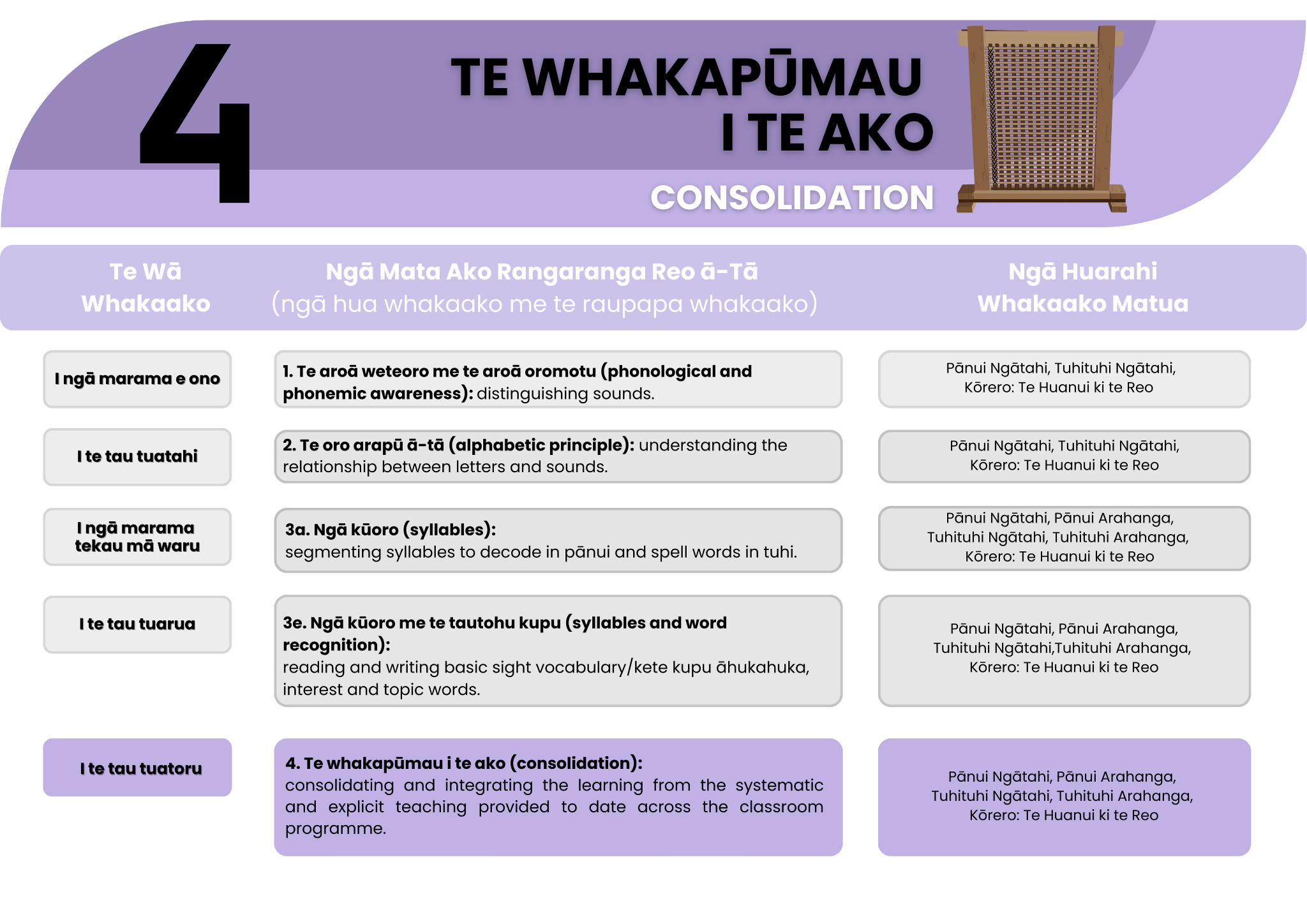
Wetewetehia kia tika
He kaingākaunui te mokopuna ki te tika o te reo.
Te whāinga
Ākonga learning focuses on accurately using and understanding basic vocabulary and sentence structures.
Ngā Tohu Ako
Te ngako o te whāinga
During a tuhituhi lesson, support ākonga to:
Organise text according to the purpose and text type, e.g., listing instructions.
Spell frequently used words correctly.
Use the macron correctly to represent a long vowel sound in words.
Attempt to spell words using the dipthongs and double vowel blends, e.g., tauhou, hiamoe, pou, hui, koa, and hue.
Use knowledge of basic sound/letter association, known spelling patterns, and sound sequencing of syllables to write a new word correctly.
Use words of particular value to their community, e.g,. places, people, activities, and events.
Use some new words related to theme work.
Use capital letters, full stops, question marks, exclamation marks, and speech marks correctly.
Write simple sentences, and some compound sentences using a comma or a conjunction, such as ā, engari, nō te mea, or heoi.
Write a series of sentences on a topic or idea.
Use resources such as word banks, classroom charts, or dictionaries such as Te Kete Kupu to check spelling.
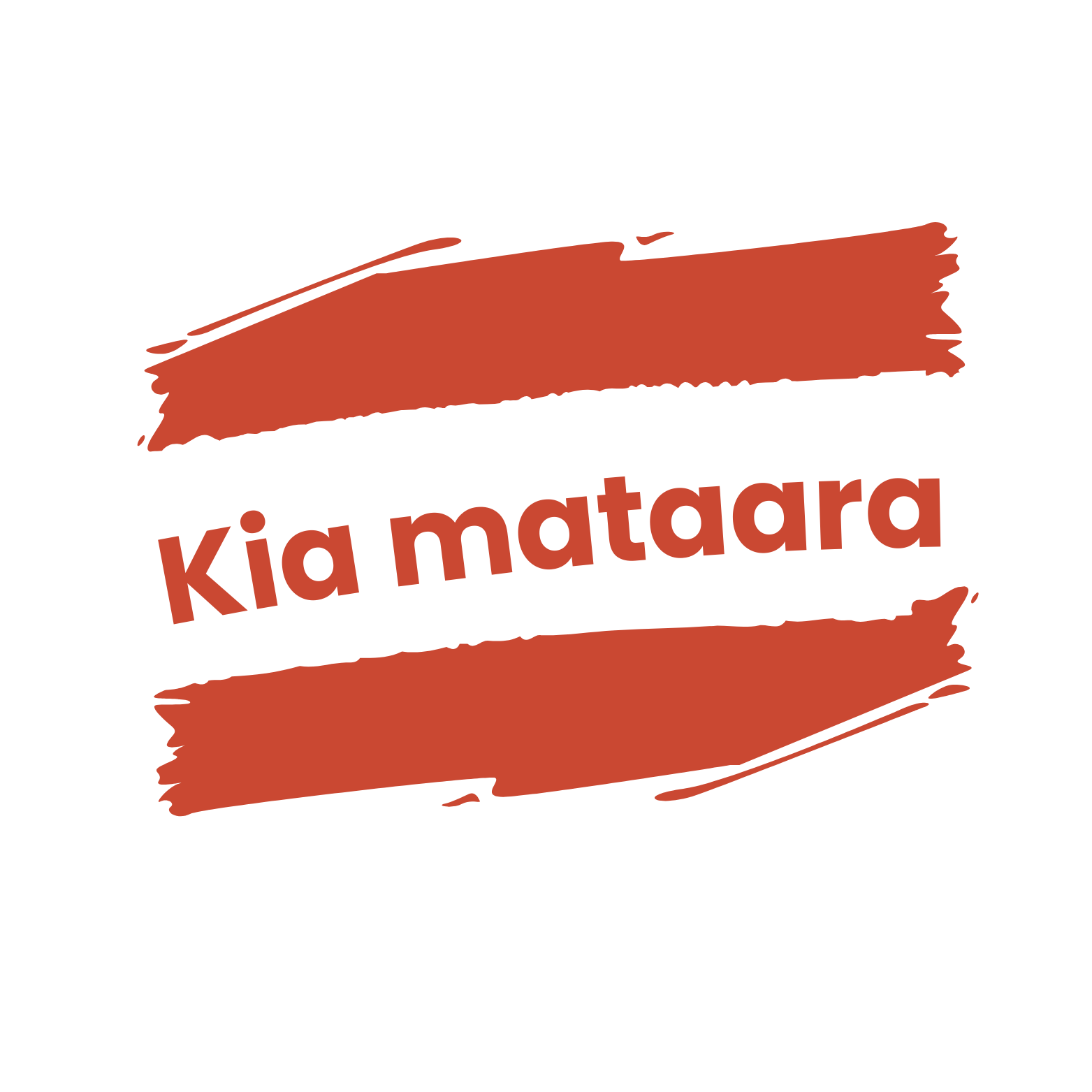
By the end of 3 years at kura, ākonga should be:
speaking in full sentences.
writing legibly.
correcting some errors in pānui and tuhituhi because they know the word they used doesn’t match the word in the text or make sense in context.
attempting to correct spelling of high frequency words when they are told an error has been made.
Ākona kia mārama
He whakaaro arohaehae te mokopuna.
Te whāinga
Ākonga learning focuses on developing basic comprehension skills and strategies.
Ngā Tohu Ako
Te ngako o te whāinga
During a tuhituhi lesson, support ākonga to:
Use some planning frameworks that are appropriate to the form of the writing to organise ideas and note down appropriate words and expressions.
Discuss ideas and information in preparation for writing.
Gather ideas from other sources, e.g., from reading texts.
Generate ideas alone and by brainstorming with peers or the kaiako.
Re-read their own writing to check that it makes sense.
Re-read their own writing and make connections to clarify meaning.
Participate in pair and group conferences for revision, with support from the kaiako.
Extend ideas generated during a guided writing session.
Write a first draft of text.
Work with the kaiako to proofread their own writing when directed, e.g., to add or delete words, to correct sentence structure, or to insert a capital letter or full stop.
Re-read text in order to attempt to identify and correct errors that they have been focusing on and self-correct where possible.
Whāia kia whakahangahanga
He whai whakaaro te mokopuna ki te āhua o tana whakapuaki i ōna whakaaro.
Te whāinga
Ākonga learning focuses on developing basic interpersonal communication skills.
Ngā Tohu Ako
Te ngako o te whāinga
During a tuhituhi lesson, support ākonga to:
Take responsibility for most aspects of the publishing process, such as publication format, layout, font, and illustration or other visual images.
Share their writing and answer questions about it.
Begin to use the language of writers and writing when sharing and responding.
Respond to feedback by adding on or deleting detail, with support from the kaiako.
Consider purpose and audience as part of planning for writing during guided writing.
Tāraia kia auaha
He whai hua, he auaha, he Māori te whakamahi a te mokopuna i te reo.
Te whāinga
Ākonga learning focuses on discovering ways to express thoughts and imagination.
Ngā Tohu Ako
Te ngako o te whāinga
During a tuhituhi lesson, support ākonga to:
Use their existing skills and knowledge to write freely.
Use a variety of expressive words to convey their thoughts and feelings.
Use a variety of descriptive words and phrases to describe people, places, things, and actions.
I te tau tuatoru: Ngā Tauira Tuhituhi
The following samples of writing by ākonga are arranged in order of skill development from top left to bottom right. Here are examples of what ākonga writing might look like in the first three years.
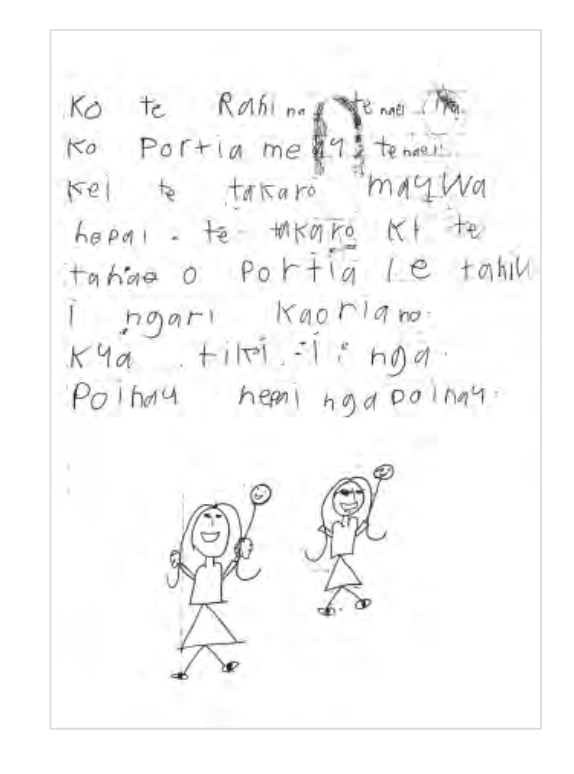
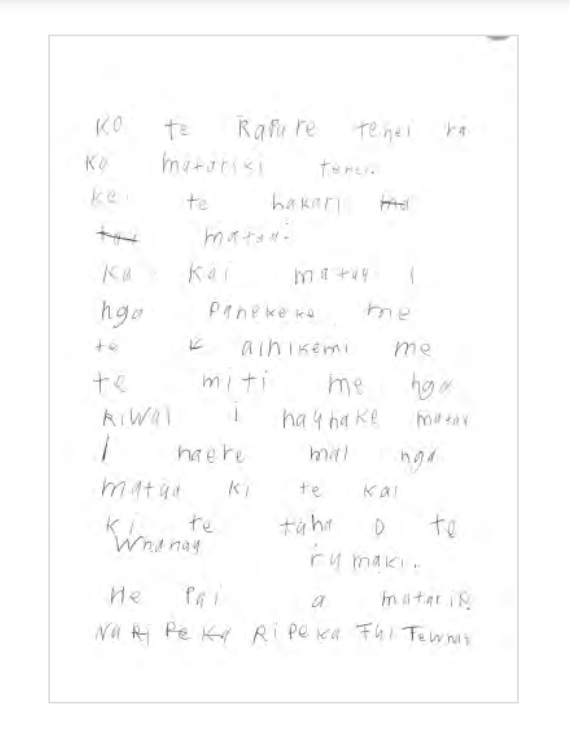
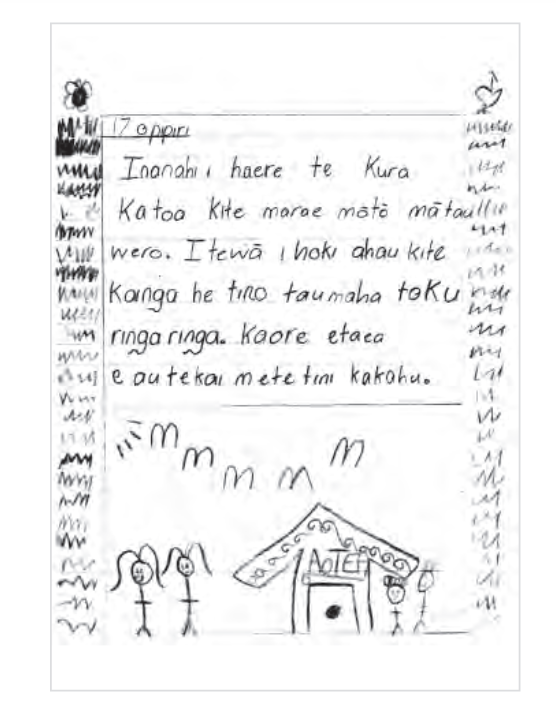
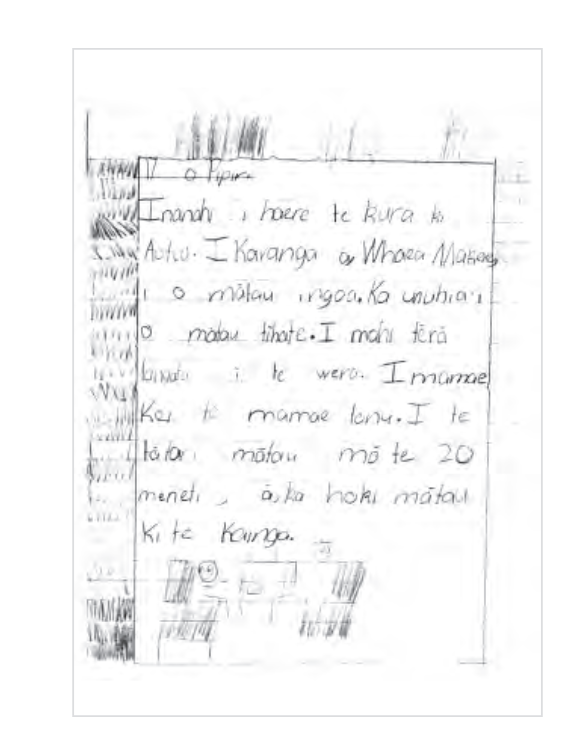
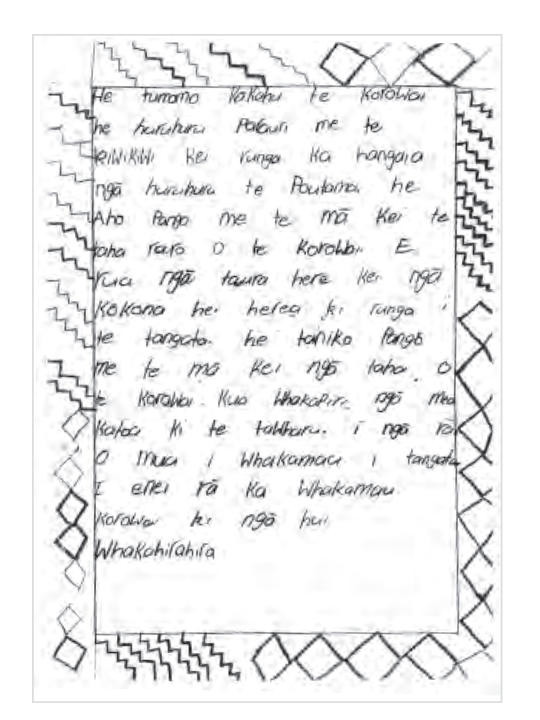
Source: Ka Rere te Manu o te Ao Tuhituhi p.29, 31
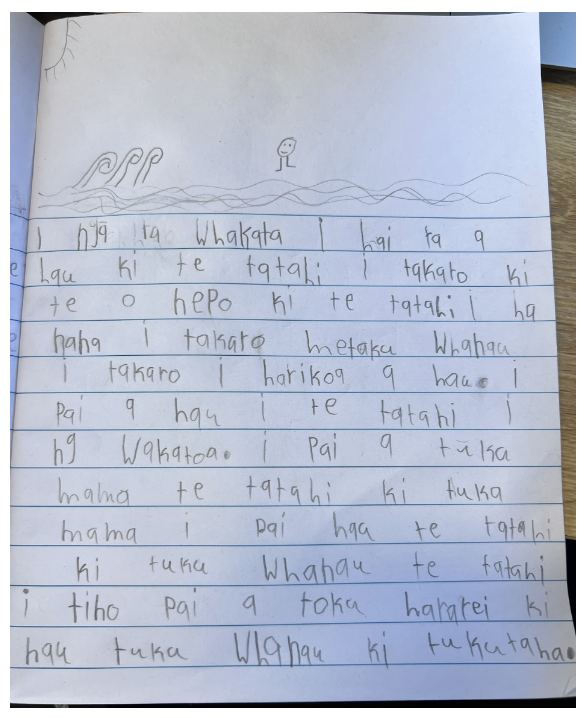
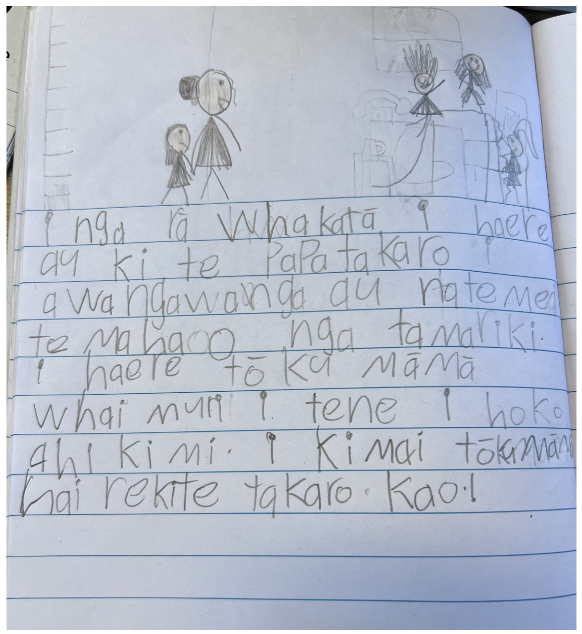
Ref: Tauira Samples: Richmond Road School
I te tau tuatoru: Te Aromatawai i te Tuhituhi
Aromatawai ō te ako (of learning) and aromatawai mō te ako (for learning).
Aromatawai should be personalised to reflect the reality that ākonga are at different stages in their learning journey and move through that journey at different speeds. This includes valuing neurodiversity (i.e. that all brains function differently) which is particularly important for neurodivergent ākonga.
Ākonga should be encouraged and supported to understand the purpose of aromatawai and be active participants in gathering information through aromatawai activities such as self-reflection, self assessment and the creation of portfolios of work that demonstrate their learning.
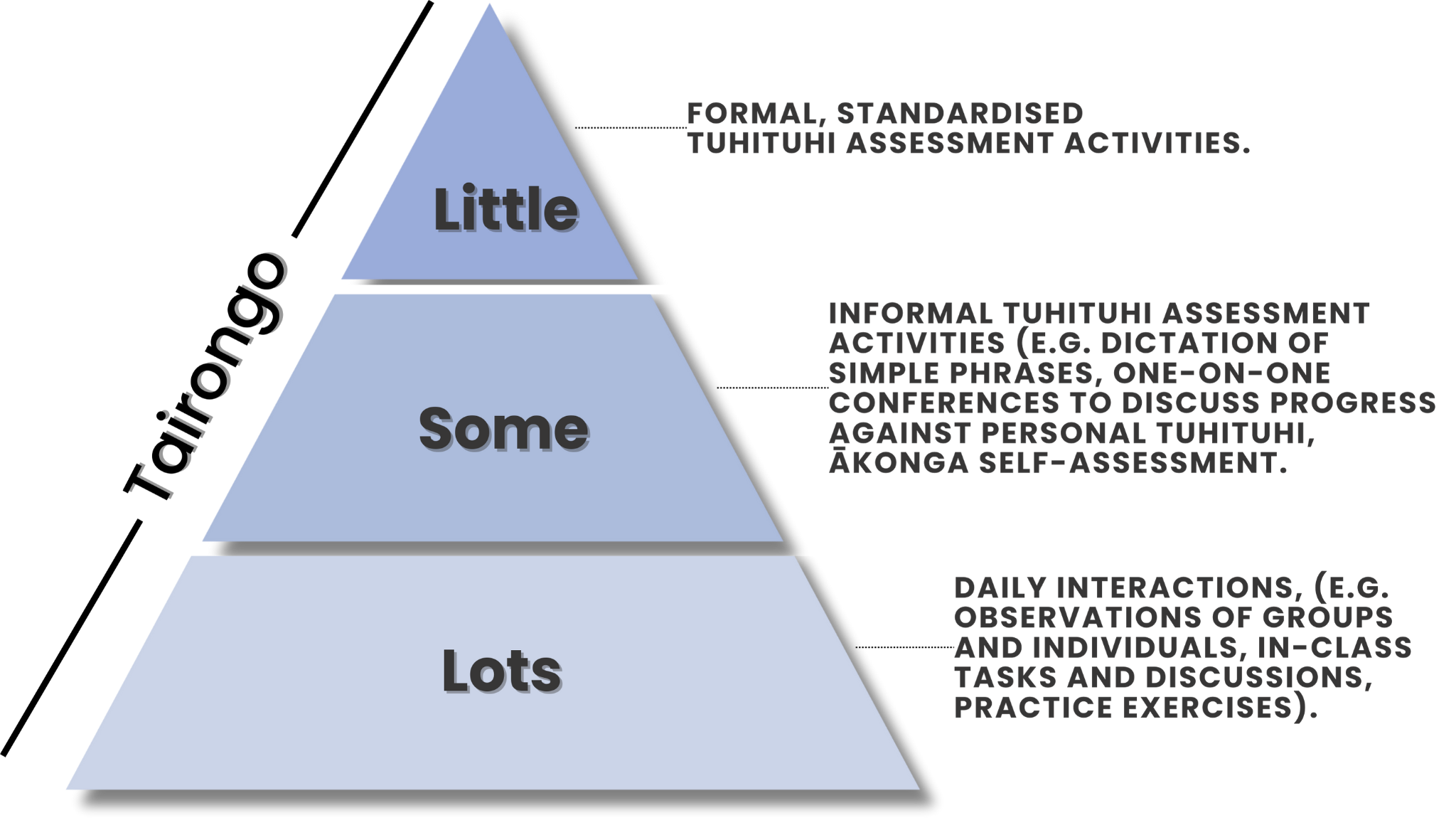
MAHI AROMATAWAI: What to look/listen for, ākonga are:
Writing sentences incorporating basic sight words, interest words, and topic words.
Developing confidence to write freely using their knowledge of syllables to incorporate a growing list of words to convey thoughts and feelings and to describe people, places, things, and actions.
Developing confidence to divide longer or unfamiliar words into syllables to aid in spelling.
Developing confidence to explain their process of segmenting words as they write, ensuring correct spelling based on their understanding of syllable structure.
Writing basic sight words correctly.
Reading what they have written correctly and with expression.
Using known rhyme patterns or spelling rules to write new words.
I te tau tuatoru: He Huarahi Tuhituhi Anō
Tuhi atu, tuhi mai | Writing to:
Involves a kaiako or more skilled writer periodically crafting a written response to content an ākonga has produced.
The focus is on making a connection with the ākonga as a writer.
Tuhi tautokotahi | Writing with:
Involves everyone in the class (including the kaiako) writing during scheduled whole class 'free writing' sessions.
The focus is for everyone to write to meet their own personal needs.
Tuhi motuhake | Independent writing:
Refers to ākonga generating content on their own.
The focus is on fostering a love of writing. The writer also has the opportunity to practice their knowledge, skill and strategies without direct support from the kaiako.
